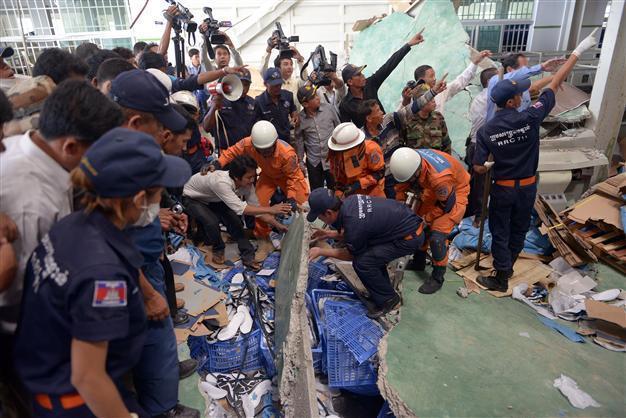After Dhaka, plant collapse in Cambodia
KAMPONG SPEU - Agence France-Presse

Cambodian rescue team and soldiers look for workers after a factory collapsed in Kampong Speu province, some 50 kilometers west of Phnom Penh on May 16, 2013. AFP Photo
A ceiling collapse at a Cambodian shoe factory killed two workers today, spurring a government vow to inspect all garment plants amid heightened safety fears after last month's disaster in Bangladesh.
Local rescue teams, helped by soldiers, scrambled to search through the rubble of the fallen structure early Thursday, which appeared to have been on a mezzanine level laden with crates of trainers and canvas shoes.
Khem Pannara, district police chief for the area in the southern province of Kampong Speu, said two staff members were killed and at least 11 injured, some seriously, adding that the rescue operation had ended.
He said the concrete ceiling had likely collapsed because it could not hold the weight of equipment stored on it due to "poor construction".
The Cambodian government said the owner of the "Wing Star Shoes" factory, which employs more than 7,000 people, would have to take responsibility for the incident.
"We will investigate the incident and take measures against those involved," minister of social affairs Ith Samheng told reporters, adding: "We will examine all factories to prevent this kind of incident from happening again." Last month a nine-storey factory complex outside Dhaka collapsed, killing 1,127 people in one of the world's worst industrial disasters. The tragedy put pressure on Western retailers that rely on cheap labour in the region, where safety standards are often inadequate.
Say Sokny of Cambodia's Free Trade Union, a national body for garment and other industrial workers, said the factory is Taiwanese-owned and produces shoes for Japanese sports brand Asics.
The owner was questioned Thursday to find out whether there was a permit for the construction and how the factory -- in Angsokun village, 50 kilometres (30 miles) south of Phnom Penh -- was built, according to national police spokesman Kirt Chantharith.
Earlier, one employee said more than 100 people work in that area of the plant each day, although she did not know how many had been there at the time of the collapse.
"I was so shocked. I am crying. I saw blood in the debris," Sokny, 29, told AFP.
Rong Chhun, president of the Cambodian Confederation of Unions, welcomed the government plan to inspect garment plants across the country.
"I applaud any measures to investigate the buildings of all factories to ensure safety for workers, but officials have to do it thoroughly and not accept bribes," he said, warning that corruption could undermine efforts.
"Garment factories in Cambodia do not meet international safety standards because the quality of the
buildings are not ensured and people have been working with a high risk of danger," he told AFP earlier.
"It happened in Bangladesh recently and now it has happened in Cambodia. We are very worried about the safety of the workers," he said.
Cambodia earned $4.6 billion from its garment exports last year but a series of strikes has highlighted festering discontent at low wages and tough conditions.
Protests by workers have also turned ugly. Three women, employees of Puma supplier Kaoway Sports, were wounded when a gunman opened fire on protesters demanding better working conditions at factories in February last year.
The shooting prompted Puma, Gap and H&M to express their "deep concern" and urged a thorough investigation.
But discontent lingers on the factory floor where 400,000 people of the 650,000 people employed in the industry work for foreign firms.
The monthly minimum wage for the hundreds of thousands of workers who make clothes for firms such as Levi Strauss of the United States and Sweden's H&M this month rose from $61 to $75, plus $5 for health care, after months of protest.
